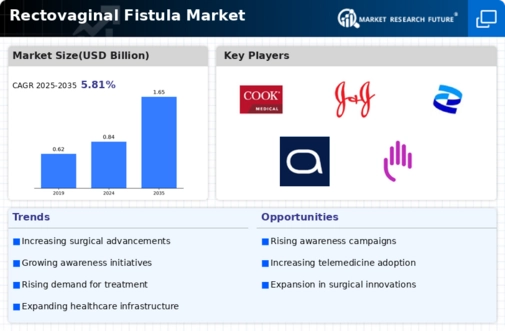Market Share
Rectovaginal Fistula Market Share Analysis
Market Share Positioning Strategies for the Rectovaginal Fistula Market
-
Targeted Marketing and Awareness Campaigns
Companies operating in the Rectovaginal Fistula (RVF) market focus on targeted marketing to raise awareness among healthcare professionals and patients. By conducting educational campaigns and participating in medical conferences, they aim to increase the visibility of their products and services. Leveraging online platforms, including social media and medical forums, helps in reaching a broader audience and educating them about the latest treatments and solutions for RVF. -
Innovative Product Development
To stand out in the competitive RVF market, companies invest in innovative product development. This includes creating advanced surgical tools, implants, and biologics that improve patient outcomes and reduce recovery times. Research and development (R&D) teams work on developing products with better efficacy and fewer side effects. Innovation also extends to improving surgical techniques and post-operative care solutions to offer comprehensive treatment options. -
Strategic Partnerships and Collaborations
Forming strategic partnerships with hospitals, clinics, and research institutions is a key strategy for market positioning. Collaborations with prominent healthcare organizations enable companies to access a wider network and gain credibility. Joint ventures and collaborations also facilitate shared research efforts, leading to the development of advanced technologies and treatment methodologies. -
Geographic Expansion
Expanding into emerging markets with increasing healthcare needs is another strategy used by companies in the RVF market. By entering regions with growing healthcare infrastructure and improving access to advanced treatments, companies can capture new market share. Geographic expansion often involves setting up local distribution channels and partnerships to effectively serve new regions. -
Adoption of Digital Health Solutions
Integrating digital health solutions, such as telemedicine and electronic health records (EHRs), is becoming increasingly important. Companies are incorporating digital tools to enhance patient management, streamline treatment processes, and offer remote consultations. Digital platforms also help in gathering patient data and improving the overall treatment experience. -
Focus on Patient-Centric Solutions
Developing patient-centric solutions is a priority for companies in the RVF market. This approach involves creating products and services tailored to the specific needs and preferences of patients. Providing personalized care, improving patient comfort, and offering support services such as counseling and rehabilitation are essential for gaining patient trust and loyalty. -
Competitive Pricing Strategies
Competitive pricing strategies are crucial for market positioning. Companies analyze pricing models to offer cost-effective solutions without compromising on quality. By balancing affordability with advanced features, companies aim to attract a larger customer base and improve their market share. Pricing strategies may also include offering discounts, bundled services, and flexible payment options. -
Regulatory Compliance and Certifications
Ensuring regulatory compliance and obtaining relevant certifications are essential for gaining market trust. Companies focus on meeting the standards set by health authorities and obtaining certifications that validate the safety and efficacy of their products. Regulatory compliance not only helps in maintaining product quality but also enhances credibility in the market. -
Enhancing Customer Support and Services
Providing exceptional customer support and services is a strategy to build long-term relationships with healthcare providers and patients. Companies offer training programs, technical support, and post-sale services to ensure that users can effectively utilize their products. Comprehensive customer support enhances satisfaction and encourages repeat business. -
Leveraging Market Research and Analytics
Utilizing market research and analytics helps companies make informed decisions and stay ahead of market trends. By analyzing market data, competitor strategies, and customer preferences, companies can identify opportunities for growth and adjust their positioning strategies accordingly. Data-driven insights enable companies to refine their marketing efforts and product offerings to better meet market demands.








Leave a Comment